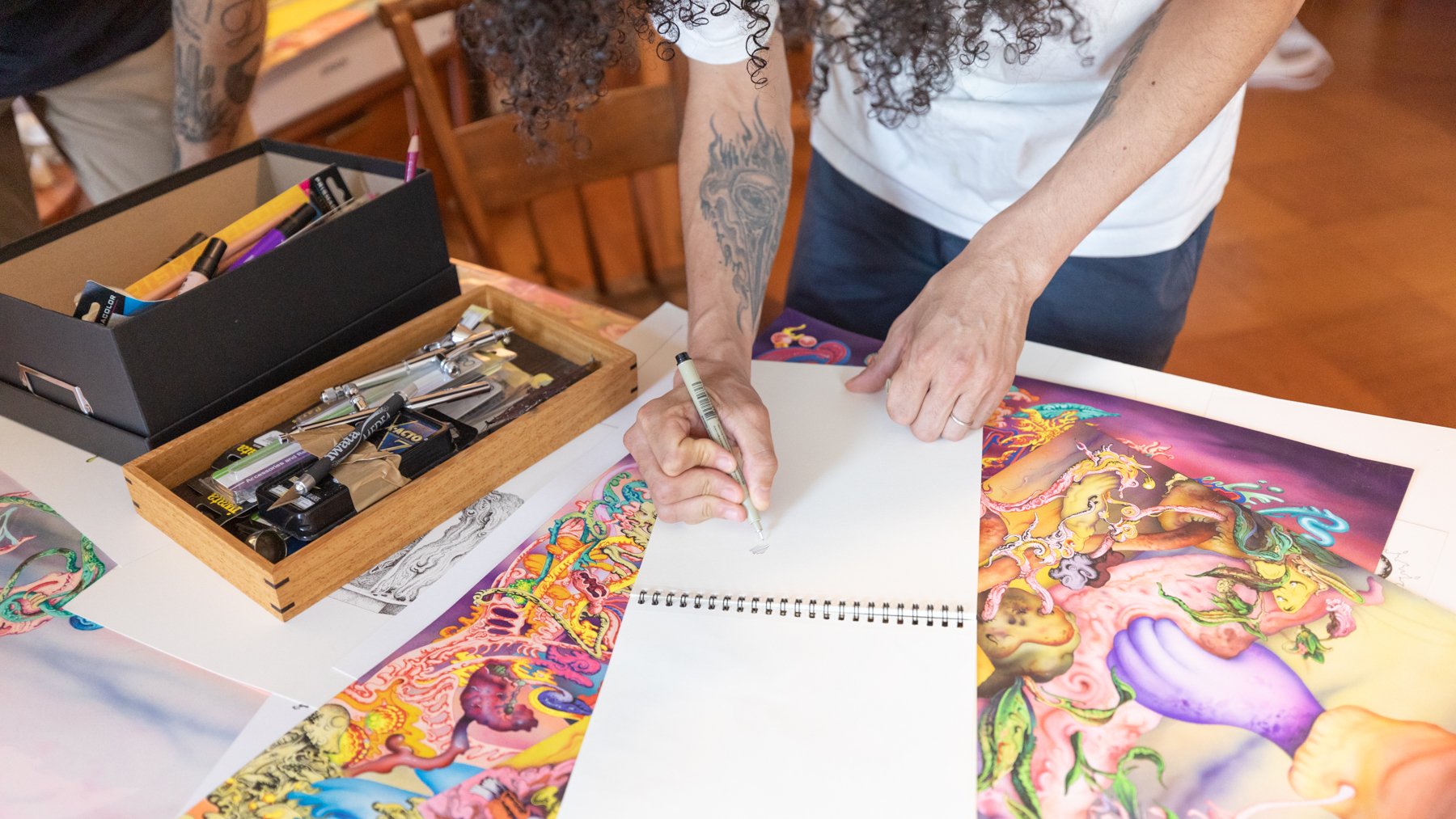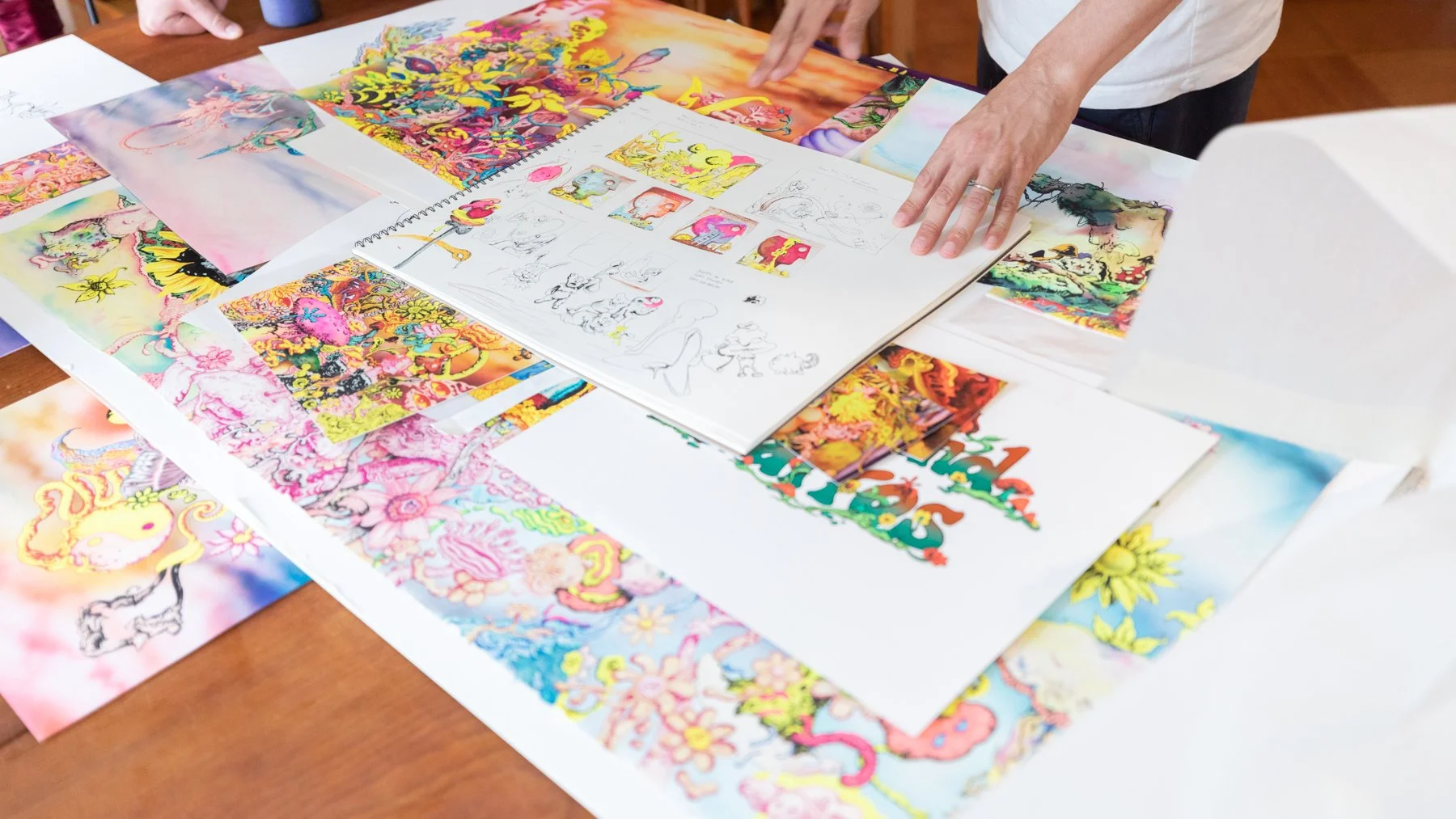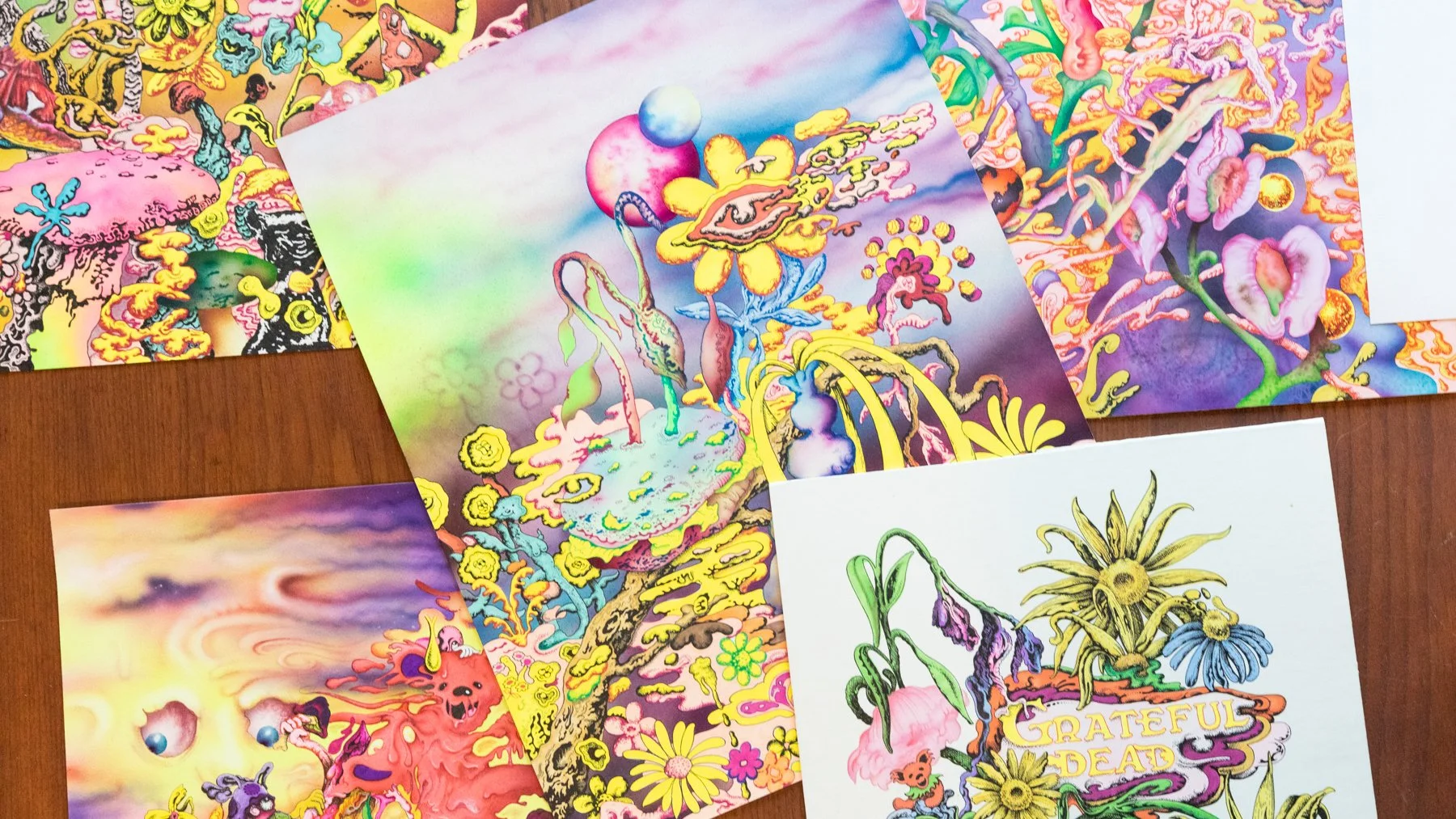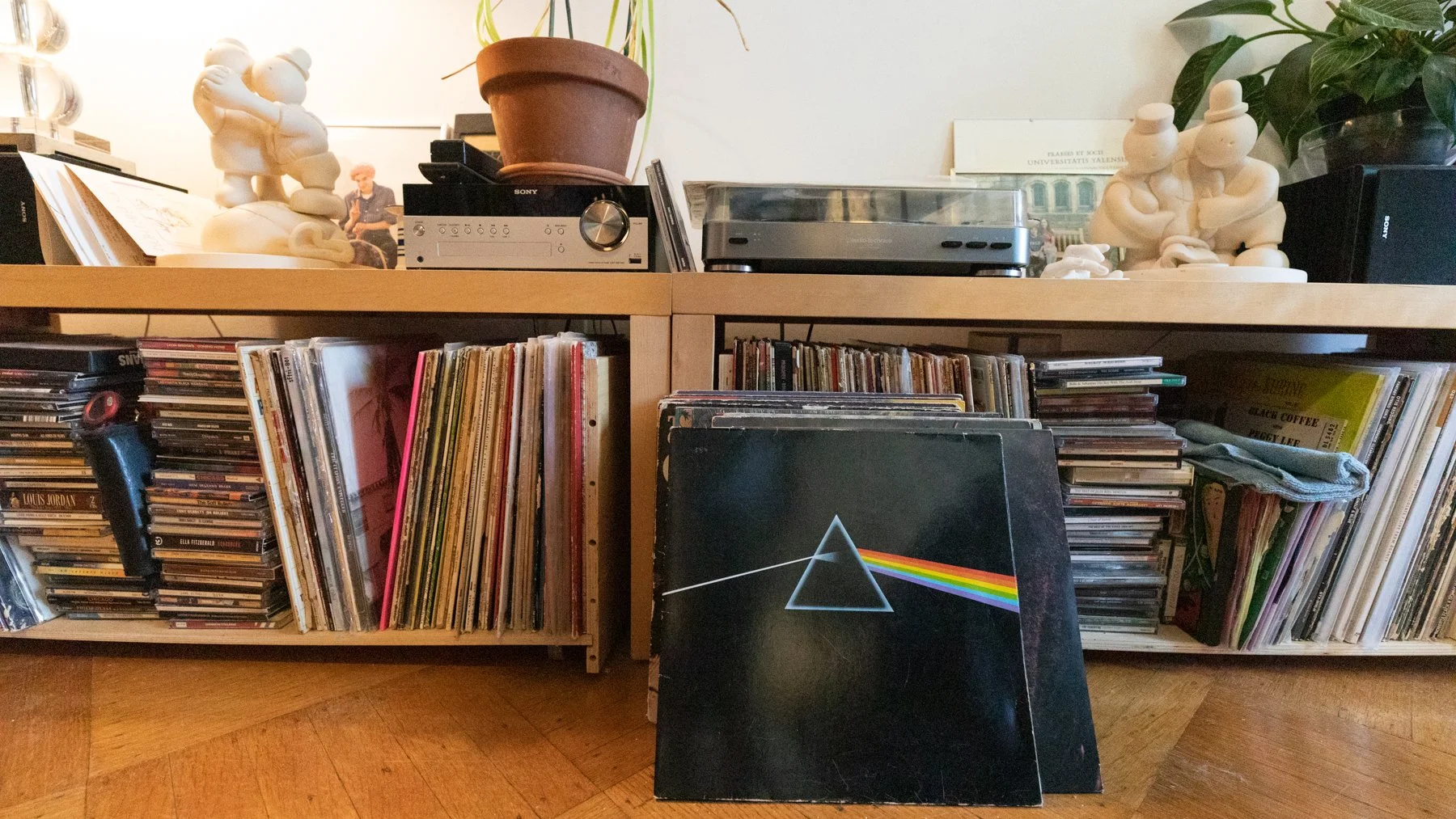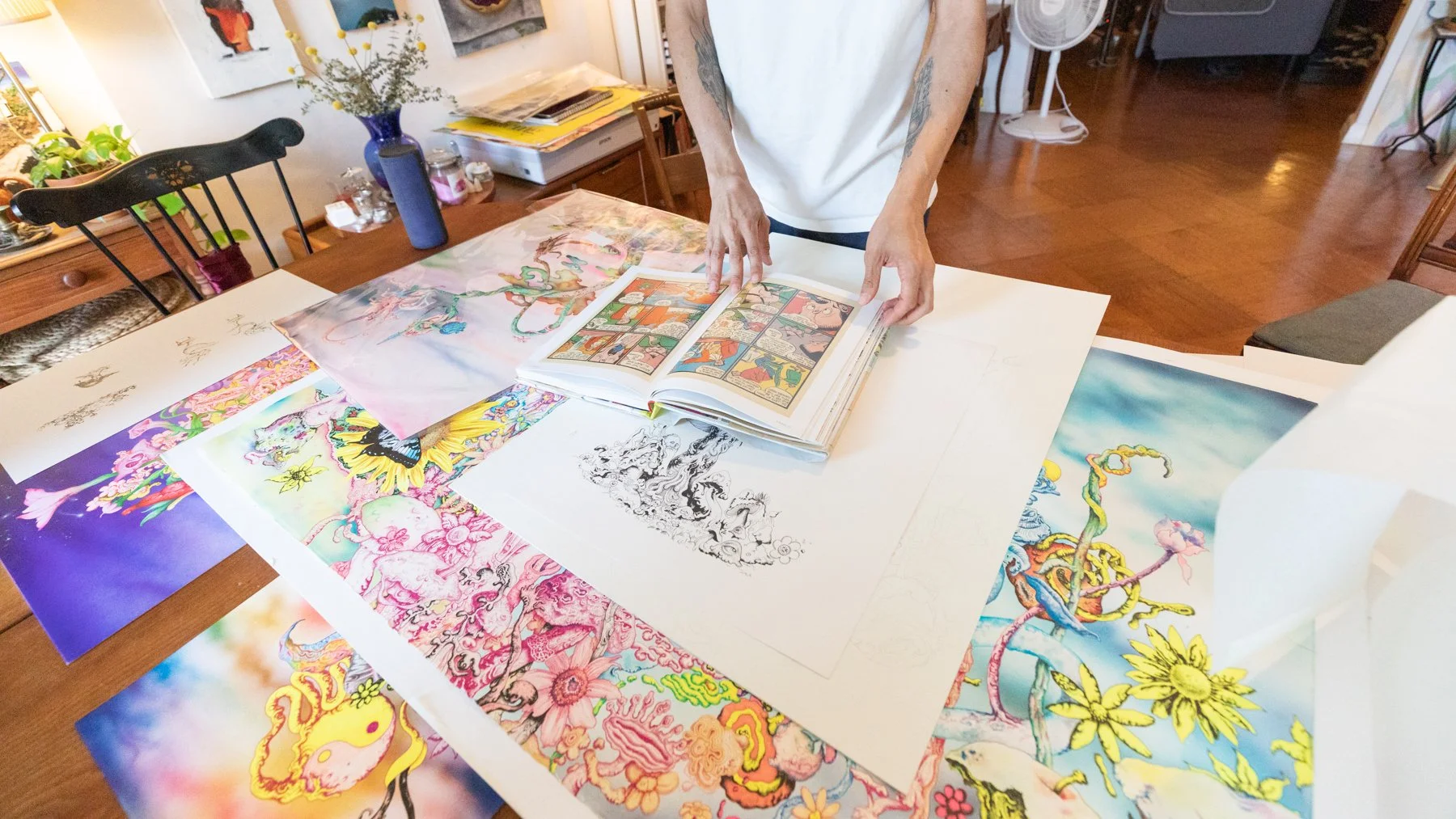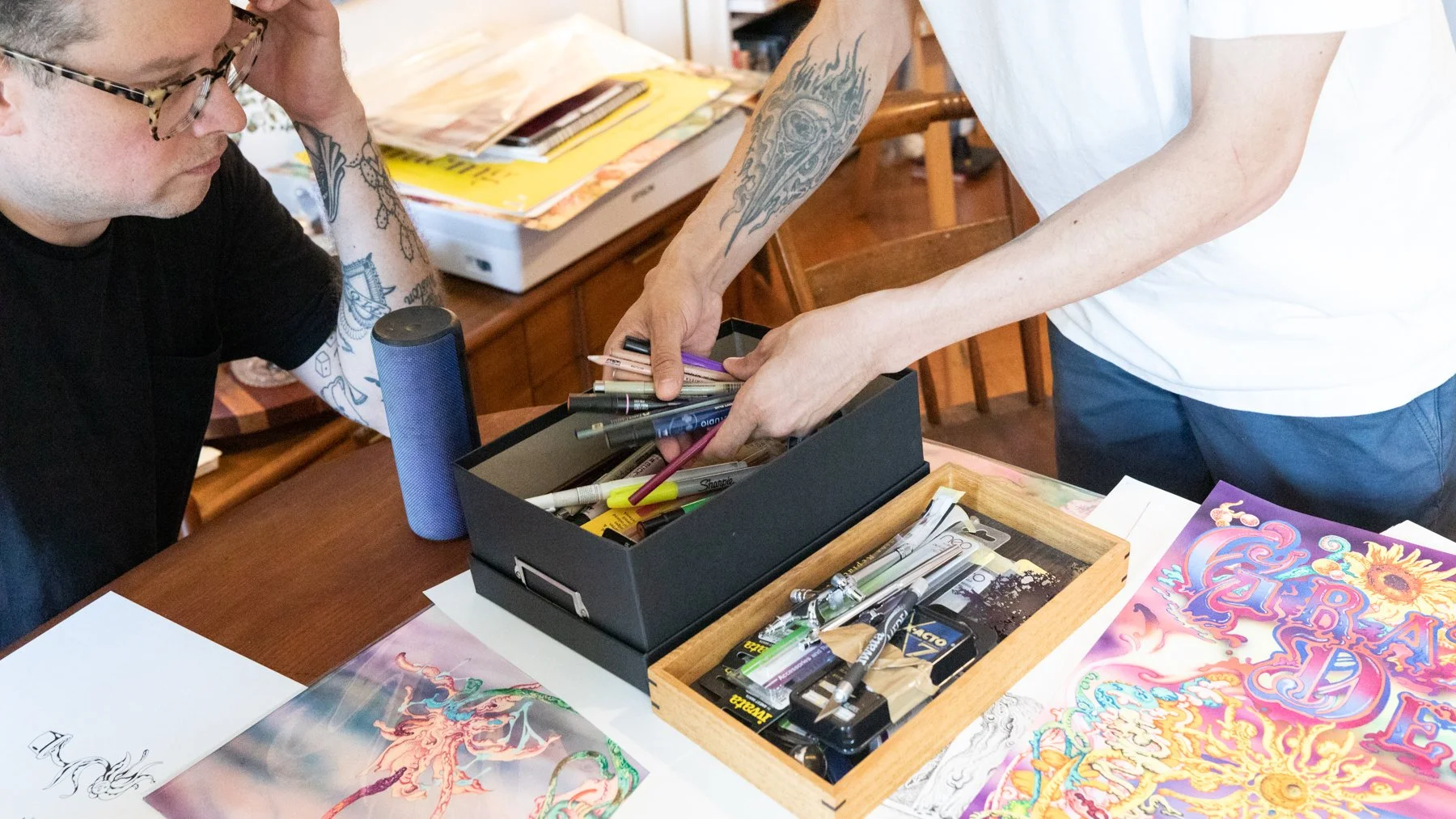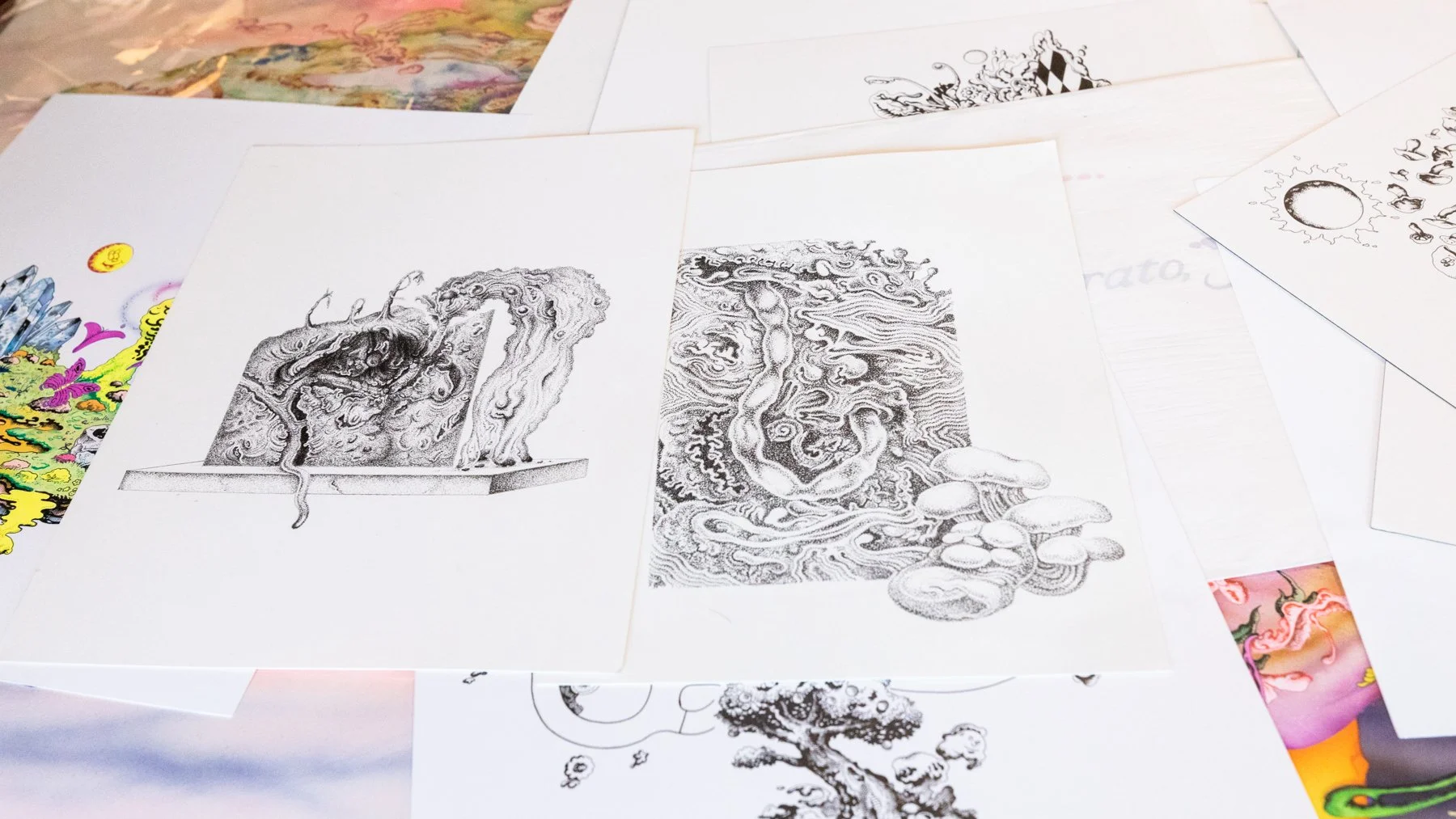Drawing Inspiration with Daniel Herwitt
Through the looking glass; over the rainbow; second star to the left and straight on ‘till morning. Follow these directions and you’ll probably find Daniel Herwitt’s studio, but today we arrive on the G train. Inside is everything you’d hope to see within an artist’s classic brownstone: piles of literature and reference books, eclectic gallery walls, and stacks of vinyl records with lush vines tumbling through the tableau.
In preparation for our arrival, Herwitt has covered his dining table in artwork of astonishing vibrancy and detail. His work has taken off on social media, but feed posts suddenly feel like a poor substitute for the real magic conjured in this room. His cat, Mrs. Meowz, jumps on the table and strolls across several masterpieces before Herwitt chuckles and gingerly lifts her off. Awestruck, we dive straight in.
Pictured (left to right): Katie Danforth, Daniel Herwitt, and John Samels.
Katie Danforth: How do you determine a composition? Do you build the world in the background and let that inform the foreground? Do you do initial sketches?
Daniel Herwitt: I'm a pretty compulsive drawer; it's a daily practice. I don't have a set plan initially, I just sort of riff on it. Most pieces will start out as just a little thumbnail idea, then I plot it out and continue from there. I was really into Dutch Golden Age still life paintings, so a lot of my work uses a similar triangular kind of composition. That's sort of what I feel about these pieces, they're all organic and sprouting outward. It's all stippling and cross hatching — very traditional ways of drawing comics, but also referencing a history of European engraving and a lot of the early Netherlandish stuff. I definitely draw inspiration from Hieronymus Bosch and Pieter Bruegel and painters like that.
KD: Also known for incredibly intricate detail.
DH: I've just always had that kind of fixation. I've been accused of wanting control over everything in my work. I have that control, but I try to make it look organic and light in a sense. Almost as fragile as a petal, so that the beauty of nature and the strangeness of it really comes through. And then all these kooky little comic characters introduce a lot of nostalgia. I think that comes working with high school kids and remembering what I was into as a teenager.
KD: So, a traditional Northern Renaissance still life can be read clockwise to reveal a narrative. Do you weave a narrative into these compositions, or do you feel the different characters interacting with the space?
DH: Yeah, I think that has changed. I do think that it's very animated and everything's moving. I've tried to codify a narrative more so through the palette. It was more rainbow in the beginning, and then I started to make more choices about how the palette can influence the narrative of it. There's not a known narrative, but it is constructed by the viewer.
KD: You do get the impression with your work that if you blink, everything will have shifted a little bit. There's just so much movement to it.
John Samels: I'm looking at two different compositions of yours, one has a bit more simplified negative space and another is much busier. How do you know when you're done?
DH: I think it's when I feel like they're alive. I feel like once it's activated, it's done.
JS: You have to commit so much more when you’re doing it by hand. I work mostly digitally, which can also be a problem. I can convince myself I’ll never be done noodling with it, but I can easily turn layers off and on. Whereas once you’ve made a decision with one of these pieces, that’s it.
DH: Yeah, and I love that challenge. I'm in this lucky zone right now with Talking Terps, and then with the Dead — I have a lot of freedom and trust at this point. I can just hand in a final piece and they'll be like, Oh, this looks awesome.
I’m hoping to link up with some more bands. I did an insert for Lady Gaga’s vinyl release a while back. That was cool. I've done some posters for King Gizzard and all that. It's fun when your work is a part of that musical world. I've always loved this stoner metal band called Sleep, and Arik Roper who does the work for them. It becomes like the sound; it becomes that world. I love that aspect when musicians and artists link up and do something special.
KD: I gotta ask, how did the Grateful Dead get in touch? How did that relationship begin?
DH: Well, I went to art school for six years, but everything really started with Instagram. This guy, @deadhead, contacted me like, I really appreciate your artwork. And then he put me in touch with Hope at Talking Terps and then they put my work out there. Someone who works for Live Nation contacted me about the Grateful Dead.
Now, I’ve been with Talking Terps for like, three years. They use other artists as well, but I do the bulk of the designs. I went to school more so as a “fine artist”. I sort of fell into this illustration world, but I always loved it as a kid: record covers and that kind of thing.
JS: Music sounds like an important creative influence.
DH: Music is huge. As a kid, hip hop and battle rap was very formative in terms of creating, like, an archetype of yourself. The poetry and the lyrics of it. Especially now with trap music, there’s that juxtaposition of these things: the jail time, the substance abuse, but then it sounds so beautiful at the same time. It's like that rotting fruit aspect. I don't necessarily listen to music all the time when I'm working because it can also be distracting. These pieces are so slow-moving that I need hours of media — NPR or whatever — just as a background sound because I can feel pretty lonely when I'm working. But when I walk, music really creates images in my head, especially different kinds of sounds within electronic music.
KD: Who would be your dream musical client? Living or dead, active or not?
DH: Oh, man. It's hard because the dream ones, I don't know if my aesthetic would fit them. Like Burial, that kind of sound where it's like you're listening to techno through the wall in a restaurant. Wu-Tang Clan, I would love that. I'd make something crazy for them. I'd love to do something dark, a chance to change up the palette. I’m also really into heavy metal, especially thrash metal. When I look at Slayer art, I'd love to use that kind of palette, but in this world…. Prince — he’s dead, but that would be awesome too because I love purple. I would make something very erotic, like a crazy flower formation.
KD: You mentioned you get most of your work through Instagram. How do you find managing a creative career on social media?
DH: I never got a website, so everything is through Instagram. If people want to buy a piece, they just message me or comment. The algorithm is unfair, and people are altering their own aesthetic choices because of what gets into the general conversation and feed — it wants your body, it wants video. I really try to avoid those pitfalls. I've been filming myself drawing more, but it still feels awkward. Then again, that's the content I like to watch.
An older generation of artists and illustrators are also on Instagram now, which is so cool. I will reach out to all those people and I just straight up ask, How did you do that highlight? Sometimes I get a response, sometimes I don't. A lot of them actually want to share that knowledge, because it has to be passed down, or you lose it, you know? It’s become a great network for me. So I think I am at peace with it.
I think that's another benefit of social media. There’s a wave of appreciation now for those artists from the sixties because now it's like people are seeing their work again. Before, you’d only see their work if you had access to those books.
JS: Speaking of books, you've got a nice library.
DH: That's another problem that I have, I'm a book hunter. I like rare, old comics — I get really jazzed about comics from the turn of the century, which are so strange. I look at a lot of this kind of material and then use it as I see fit. Obviously R. Crumb is a huge inspiration, all those Zap guys. That’s a big inspiration for the work. I'm just trying to keep up these traditions of art making, you know? Especially now with AI, I am hopeful that people still want a human warmth in artwork, that visceral experience.
I respect the digital, but I want to be a part of that handmade tradition. That's important to me.
KD: As a high school teacher, you must have more insight than most on how this new generation is using these digital tools.
DH: Yeah, I think sometimes parents are so concerned about, like, TikTok and Roblox and all of that consuming their children — which they should be. I have to keep my son in check about that stuff, too. But there are a lot of kids who are very interested in how to be creative. They definitely inspire me.
KD: Do you make art with your son, too? Is that how he expresses himself?
DH: [Laughs] We play Fortnite together. No, I tried, but I think it's that kill the father mentality. I almost pressured him. I was like, Look, this is what I can teach you how to do and we could work together in the future. But, that didn't happen.
He'll dabble, but he's just not into it as much. For me, even as a kid, I was very compulsive. I saw it as a power, you know? I thought of it as magic. As you get older, that magic's ripped away. I've tried to retain it through the way I work.
KD: Nature also seems to be a source of magic for you. We’re here in New York — not famous for its natural splendor. Do you ever have to leave the city and recharge, or where do you find that?
DH: I'm trying to find my peace with that too ‘cause I think sometimes I forget to recharge. I'm from Boulder and my mom lives close to the Rocky Mountains. I used to go on hikes in high school and that was a way to de-stress — I’d forgotten about that lifestyle a little bit. But it’s no wonder I began drawing flowers, it’s what I was looking at.
I do need to give myself more respites. I love New York City so much, but sometimes I forget about [gestures] out there, you know?
KD: Yeah, I get it. I grew up in Northern California; getting out into nature is how I learned to decompress. Being out here, I'll just keep running and I'll forget that I need that until everything comes to a screeching halt. Or until I get away and realize I was waiting to exhale this whole time.
DH: Right. I definitely had that moment in Colorado, just remembering all the beauty. But here, I'm into a different kind of beauty. I go on a lot of walks to process my thoughts. I love areas of the city…like under a bridge, or near the Gowanus canal. Those kind of cruddy places where all the trash starts to build up, but there’s plants growing out. I know it sounds romantic, but that kind of nature also fascinates me — the destitute nature.
I do love living in the city. It can be a hell, but at the same time it provides endless energy for me.
This interview has been edited for brevity and clarity. We’d like to thank our friend Daniel Herwitt (@sunflower_form) for joining us, along with the following acknowledgement from the artist:
I want to thank my family and friends for their continued love and support of my art, especially my love Suzy and my beautiful son, Driver. Thank you!
To learn more about artist sourcing opportunities, email us at info@colossalmediagroup.com.

